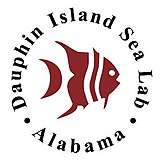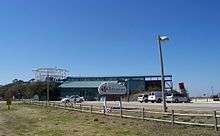Dauphin Island Sea Lab
The Dauphin Island Sea Lab (DISL) is Alabama's primary marine education and research center. DISL is the home site of the Marine Environmental Sciences Consortium and was founded by an act of the Alabama State Legislature in 1971. It also has a public aquarium specializing in estuarine organisms, the George F. Crozier Estuarium.
 | |
| Date opened | 1971 |
|---|---|
| Location | Dauphin Island, Alabama, United States |
| Coordinates | 30°15′01″N 88°04′43″W |
| Website | www |
The facilities are located on the East end of Dauphin Island, and occupy grounds formerly owned by the US Air Force for the 693rd Radar Squadron.[1] It is located across the street from historic Fort Gaines.[2]
Estuarium

The George F. Crozier Estuarium is part of the Discovery Hall educational program at the Dauphin Island Sea Lab. It includes a 10,000 square foot Exhibit Hall and a Living Marsh Boardwalk. The Exhibit Hall features four exhibits highlighting aquatic life that could be found in the Mobile-Tensaw River Delta, Mobile Bay, the Barrier Islands and the Northern Gulf of Mexico.[3]
- The Mobile-Tensaw River Delta exhibit recreates Alabama's largest wetland, the Mobile-Tensaw River Delta and features multi-species displays featuring the American alligator, turtles and gar.
- The Mobile Bay exhibit features a replica of the legs of the Middle Bay Lighthouse and houses native species found in the brackish water of Mobile Bay, including stone crabs, horseshoe crabs, blue crabs, oysters, spadefish, and flounder.
- The Barrier Islands exhibit features saltwater species commonly found on and around Alabama's barrier islands, including shrimp, blue crabs and hermit crabs.
- The Northern Gulf of Mexico exhibit includes displays of the different marine communities of the Northern Gulf of Mexico and features octopus, lobsters, eels, seahorses, red snapper, sharks and jellyfish.
- Rays of the Bay is the latest exhibit added to the Estuarium. Opened in March 2013, the 6,400 US gallons (24,000 l) touch tank houses six sets of four species of rays and skates indigenous to the Northern Gulf of Mexico and Mobile Bay. The species include the Southern stingray, Cownose ray and Atlantic stingray.[4]
Research
It was announced in August 2014 that the Dauphin Island Sea Lab would open a new 2,300 square feet (210 m2) research facility in mid-2015 dedicated to studying dolphin, manatee and whale strandings on the Alabama Gulf Coast. The Alabama Marine Mammal Stranding Network (AMMSN) took residence in the new facility on May 22, 2015.[5]
References
- Air Defense Radar Station - Dauphin Island AFS
- Motyka, john (2007-03-23). "You Can Call It the Little Easy". New York Times. Retrieved 2007-05-08.
- "Estuarium Exhibits". disl.org. Archived from the original on 2008-02-22. Retrieved 2014-08-26.
- Raines, Ben. "Reach out and touch a stingray in the Estuarium's new Rays of the bay exhibit". Press Register. Retrieved 2013-09-03.
- Finch, Michael. "Dauphin Island Sea Lab to get new research center for study of marine strandings in the Gulf of Mexico". Press Register. Retrieved 2014-08-26.